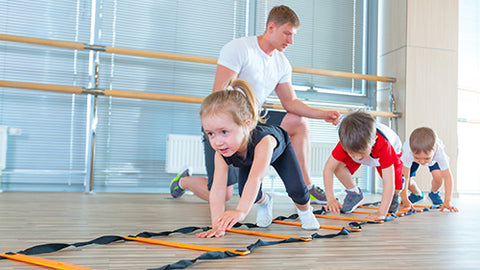In today’s fast-paced world, ensuring Fitness for Kids has become a crucial aspect of childhood development. While technology and sedentary lifestyles have made it easier for children to stay indoors, the significance of active play cannot be overlooked. Engaging in physical activities not only promotes physical health but also nurtures creative thinking, social skills, and emotional well-being.
Fitness for Kids

Physical fitness is essential for children as it lays the foundation for healthy habits that can last a lifetime. In addition to strengthening their bodies, engaging in regular exercise helps children develop coordination, balance, and agility. It also provides opportunities for them to explore their surroundings, boost their self-esteem, and foster connections with peers.
The Importance of Physical Activities for Children
Children are naturally energetic and curious. They thrive when given the opportunity to move, explore, and engage in various physical activities. According to numerous studies, regular physical activity contributes to healthy growth and development, reducing the likelihood of obesity and associated health issues.
Engaging in outdoor play allows kids to experience the joy of fresh air and nature while developing critical motor skills. Whether it’s running, jumping, climbing, or playing sports, being physically active helps improve cardiovascular health and strengthens muscles and bones. Moreover, it can combat anxiety and depression by releasing endorphins, the body’s natural mood lifters.
Additionally, physical activity is known to enhance cognitive function. Research suggests that children who are active tend to perform better academically than their sedentary counterparts. This correlation indicates that movement and brain function are intricately connected, reinforcing the notion that active play is vital for holistic development.
Building Healthy Habits Early On
Encouraging an active lifestyle from an early age instills healthy habits that children are likely to carry into adulthood. Parents and caregivers play a foundational role in shaping children’s attitudes towards fitness. By modeling active behavior and emphasizing the importance of exercise, adults can cultivate a positive mindset around physical activity.
Creating environments that promote movement—such as providing access to parks, playgrounds, and safe spaces for play—is also essential. When children see their parents engaging in fitness routines or enjoying family walks, they are more likely to participate themselves.
Moreover, introducing structured activities like dance classes, martial arts, or team sports can provide children with a sense of belonging and teamwork, fostering social skills and cooperation. These experiences help develop a love for fitness that transcends mere obligation.
Making Fitness Enjoyable
One of the most significant challenges in promoting Fitness for Kids is overcoming the perception that exercise is a chore rather than a fun activity. To nurture a love for movement, it’s crucial to incorporate playfulness into physical activities.
Games like tag, hide-and-seek, or obstacle courses allow kids to exercise without realizing they’re working out. Encouraging imaginative play can also spark creativity; building forts, pretending to be superheroes, or engaging in dance parties can all contribute to physical fitness while keeping the spirit of fun intact.
Innovative approaches such as turning household chores into playful challenges can encourage kids to move and stay engaged. For example, racing to complete tasks or timing themselves during chores transforms mundane activities into enjoyable games.
Creative Ways to Encourage Fitness for Kids at Home
Creating an environment that fosters Fitness for Kids at home requires creativity and commitment. With some ingenuity, parents can transform any space into a vibrant playground where movement becomes a natural part of daily life.
Designing a Home Fitness Space
Designing a designated area for physical activities can be a game-changer for encouraging fitness at home. A spare room, basement, or even a backyard can be transformed into a mini gym or play zone. Equip the space with age-appropriate workout gear such as yoga mats, small weights, resistance bands, and balls.
Consider incorporating colorful visuals, motivational quotes, and interactive elements like chalkboards to draw kids’ attention. Creating a fun atmosphere not only encourages them to spend time there but also makes exercising feel more inviting.
Safety should be a top priority in this space. Ensure that the area is free of obstacles and hazards, providing soft surfaces for activities where children may fall.
Incorporating Technology Wisely
While excessive screen time can lead to a sedentary lifestyle, technology can also serve as a valuable tool in promoting Creative Ways to Encourage Fitness for Kids at Home. Interactive video games that require physical movement, such as dance or fitness games, can provide a fun way for children to get their hearts pumping.
Moreover, online workout videos tailored to kids can introduce them to new forms of exercise, from yoga to aerobics. Many platforms now offer guided exercises that are both entertaining and educational. Setting up a weekly family workout session using these resources can make exercise a shared experience, enhancing motivation and accountability.
However, moderation is key. It’s important to balance screen time with outdoor activities that allow kids to connect with nature and explore their surroundings.
Organizing Fun Challenges and Competitions
Another engaging method to encourage Fitness for Kids is through friendly competitions or challenges. Setting up weekly themes—like “Move-It Monday” or “Fun Fitness Friday”—can spark enthusiasm and anticipation among kids.
You can organize small competitions, such as who can do the most jumping jacks in a minute or create obstacle courses in your garden. Rewards for participation, such as stickers or simple prizes, can motivate children and turn fitness into a delightful challenge rather than a routine.
Get creative with team challenges too! Family relay races or scavenger hunts can involve everyone and promote collaboration. By integrating fun into fitness, children are more likely to embrace exercise as an integral part of their lives.
Emphasizing Outdoor Activities
Spending time outdoors is immensely beneficial for both physical and mental health. As part of encouraging Fitness for Kids, make outdoor play a weekly ritual. Plan family outings to parks, nature trails, or beaches where physical activities like hiking, biking, swimming, or playing sports can take center stage.
Introduce children to the beauty of nature through activities like gardening or nature walks. Not only will they engage in physical movement, but they will also learn about the environment and develop a sense of appreciation for the great outdoors.
Create a family tradition around outdoor play, such as weekend picnics that include active games. The goal is to inspire kids to view outdoor activity as a source of joy and relaxation, cultivating a lifelong passion for fitness.
Conclusion
Promoting Fitness for Kids isn’t merely about preventing health issues; it’s about nurturing happy, confident, and well-rounded individuals through active play and movement. By implementing creative strategies at home, parents can significantly influence their children’s relationship with fitness.
From designing dedicated play spaces to leveraging technology wisely, the possibilities are endless. Remember, the key lies in making fitness a fun, engaging adventure rather than a rigid obligation. By embracing the joy of movement and exploration, children will develop not just physical capabilities but also essential life skills they can carry into adulthood.
Overall, the journey of encouraging fitness at home is one filled with laughter, creativity, and wonderful memories that will strengthen family bonds while prioritizing health. Through active playtime adventures, we empower the next generation to embrace movement as a natural, enjoyable part of their lives.
Hydration for Kids: Essential Tips for Keeping Your Child Properly Hydrated

